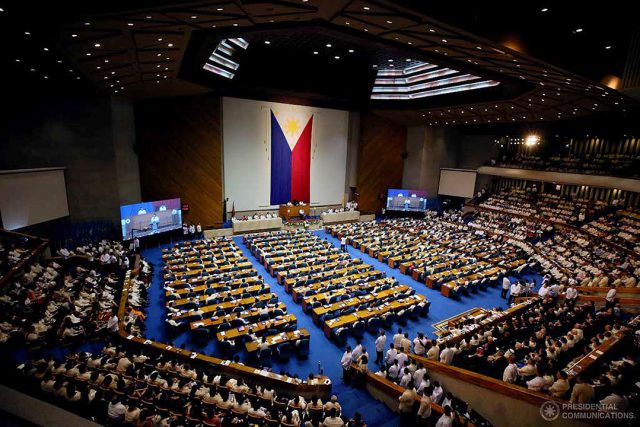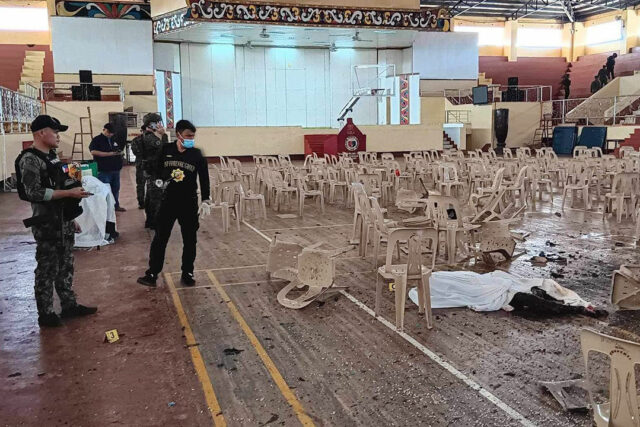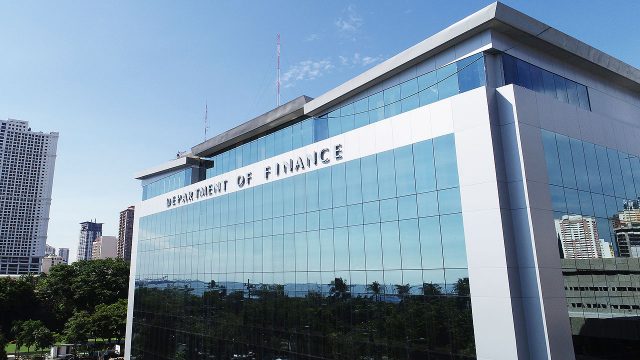Experts, officials clash over economic ‘Cha-cha’
By John Victor D. Ordoñez, Reporter
WHILE legal and business experts told the Senate on Monday that the government must first fulfill its poverty reduction goals and streamline bureaucratic bottlenecks that deter the entry of foreign investors, the finance department maintained its openness to easing economic restrictions in the 1987 Constitution.
“The question right now is timing and removing all those restrictions, today is not the right time to amend, 21% of Filipinos are still living in poverty,” Bernardo M. Villegas, economist and one of the framers of the 1987 Constitution, told the Senate hearing on Resolution of Both Houses (RBH) No. 6, which seeks to ease Charter-based restrictions on foreign investments.
Earlier, President Ferdinand R. Marcos, Jr. asked the Senate to review economic provisions of the Constitution amid calls for a people’s initiative to push for Charter change (Cha-cha). His administration is aiming to reduce poverty incidence to 9.0% by 2028.
“Right now, we should have a single-minded focus on the scandal that 21 percent of our population is living in demonizing poverty,” Mr. Villegas told the Senate.
Based on the latest Philippine Statistics Authority (PSA) report, the poverty rate for the first half of 2023 decreased to 22.4% from 23.7% in the same period in 2021, bringing the estimated number of Filipinos whose income was not enough to buy basic food needs to 9.795 million. In 2021, the figure was 10.945 million and 9.031 million in 2019.
BDO Capital and Investment Corp. President Eduardo V. Francisco told the same hearing that foreign investors have mainly been complaining about the slow bureaucracy and red tape when approving foreign-funded projects.
Citing his experience with foreign investors, Mr. Francisco said it takes about 167 signatures to approve a foreign investment renewable energy project, adding that it used to take 250 signatures to get projects up and running.
Former chief justice Hilario G. Davide, Jr. earlier told senators that Congress should focus on cutting red tape and corruption instead of easing foreign restrictions under the 1987 Constitution.
For its part, the Department of Finance (DoF) reiterated that it is open to easing economic restrictions in the 1987 Constitution same as the President’s stance.
“Allow me to make it clear. This administration’s position in introducing reforms to the Constitution extends to economic matters alone, for those strategically aimed at boosting our economy. Nothing more,” Mr. Marcos said last week.
“We are echoing the position of the President to consider the economic provisions of the Constitution so that certain sectors of the economy are opened up,” Finance Undersecretary Bayani H. Agabin told the senators on Monday.
The Joint Foreign Chambers of Commerce in the Philippines (JFC) also reiterated its stance of supporting easing foreign economic provisions in the current Charter at the same hearing.
“It (JFC) supports and promotes open international trade, free investment and improved conditions of business that’s what we advocate,” Canadian Chamber of Commerce of the Philippines President Julian H. Payne, speaking for the JFC, said. “The Joint Chambers of Commerce supports the easing of restrictions on foreign direct investment (FDI) wherever this is possible.”
He added that removing these restrictions would boost FDI in sectors where foreigners have limited ownership.
The Senate is in the middle of deliberating on the RBH 6, which is seeking to ease foreign ownership restrictions in education, public utilities and advertising.
DEBATE ON PUBLIC UTILITIES
Mr. Payne said that using legislation or executive action instead of restrictions in the Constitution would allow for more timely adjustments with international business conditions, citing recent amendments to the Public Service Act.
Congress earlier passed changes to the 85-year-old law to allow full foreign ownership in domestic shipping, telecommunications, shipping, railways and subways, airlines, expressways and tollways, and airports.
Senator Mary Grace Poe-Llamanzares, who sponsored the Senate bill amending the Public Service Act, said opening up public utilities to foreign ownership could “open a can of worms” might threaten national interests.
“This is not just a discussion about the entry of foreign capital and businesses,” she said at the hearing in mixed English and Filipino. “Other countries would be able to country our water, electricity, seaports, gasoline and our public utility jeeps. Are we ready for this?”
“The Philippines today has one of the most liberal foreign investment laws in ASEAN (Association of Southeast Asian Nations) as well as in Asia,” former Supreme Court Associate Justice Antonio T. Carpio told senators on Monday.
“The Philippines without amending the Constitution has passed several laws to open the economy to 100-percent foreign ownership.”
HOUSE LEVELS WITH PRESIDENT ON ‘CHA-CHA’ FOR INVESTMENTS
Meanwhile, the House of Representatives will follow the President’s push for economic amendments to the 1987 Constitution to allow more foreign investors into the country.
“The House will follow the President,” Albay Rep. Jose Ma. Clemente S. Salceda said in a news briefing.
“Effectively, the instruction of the President is [to] let the Senate do its work on RBH (Resolution of Both Houses) 6,” Mr. Salceda said.
“In effect, I think we’re shelving PI (people’s initiative)…because that is the instruction of the President,” Mr. Salceda said, in hopes to brush off the politicizing of Charter change.
Mr. Salceda said that opening the economy to foreign direct investments would help achieve the Marcos administration’s goal of achieving upper middle-income status by 2025.
He said that upper middle-income status begins at $4,256 gross national income (GNI) per capita. The Philippines’ GNI per capita is around $3,950, Mr. Salceda noted, and is expected to grow at $4,466 by next year.
“So, we need to grow our GNI per capita by a combined 13% between 2024 and 2025 to make it, or around 6% per year in 2023 and 2024,” Mr. Salceda said in a separate statement.
Marikina Rep. Stella Luz A. Quimbo said that amending economic provisions of the Charter must go hand-in-hand with addressing issues in the country’s bureaucracy.
“Charter change (“Cha-cha”) is not a panacea for all our country’s economic ills. There must also be remedy for corruption, red tape, and expensive electricity,” Ms. Quimbo told the briefing in a mix of English and Filipino.
She cited Australian telecommunications company Telstra, which backed up last minute from entering the Philippine market in 2017 due to “so much unpredictability in the regulatory environment.”
Ms. Quimbo said pushing for economic Charter change is the “clearest signal to our foreign investors that… the Philippines is sure with what it wants to do, which is to open up to the economy.”
“Economic Cha-cha, which merely is for the reduction of inflexibilities rather than prescribing its parameters, is not about opening the floodgates to undermine local stakeholders but about laying the groundwork for intelligent and sustainable foreign investment that complements our local industries,” Ms. Quimbo added.
RBH 2 OVER RBH 6
Senators have begun deliberations on RBH 6, which seek to open the Philippines to foreign investments in public utilities, education, and advertising through constitutional change.
However, Mr. Salceda renewed his push for the House’s RBH 2, which extends foreign investments in agriculture, education, land lease and ownership, conveyance, media and advertising via “Cha-cha.”
“The House-proposed RBH 2 touches on a much bigger share of the economy, so naturally, it has a significantly greater growth potential,” he said.
The House’s resolution would unlock 16.53% in economic output, higher than 3.51% gross domestic product (GDP) share in the Senate’s RBH 6.
Congressmen are willing to engage in debates with its counterparts in the Senate regarding constitutional change, they said.
“I wish that the Senate would engage in a healthy debate about the economic provisions,” House Deputy Speaker and Quezon Rep. David C. Suarez told the briefing. — with a report from Beatriz Marie D. Cruz
Landslide toll climbs to 55; aid pours in for Mindanao
By Kyle Aristophere T. Atienza, Reporter
THE DEATH toll from a landslide that struck the mining town of Maco, Davao de Oro province a week ago has climbed to 55, authorities said on Monday as aid poured in for areas of Mindanao plagued by disasters wrought by heavy rains in the past weeks.
In a situation report, the Davao de Oro province’s disaster agency said 32 people were still missing as of 7 a.m. on Monday after a landslide in the village of Masara last week.
The tally of missing individuals was still ongoing. On Sunday, 63 people were considered missing.
The landslide happened in the gold-mine village at around 7:40 p.m. on Feb. 6, amid heavy rains due to the combined effects of a northeast monsoon and the trough of a low-pressure area.
Apex Mining Co, Inc. earlier said the area where the landslide occurred was a vehicle terminal for buses and jeepneys servicing its employees as well as members of the community.
Masara, which had a population of 1,125 as of May 2020, was also the site of two landslides in September 2008 that killed 24 people and left two missing.
Operations of 300 rescuers from different disaster teams had been facing interruptions as they searched the area, Edward Macapili, an executive assistant on information and communications at the provincial government, said in a radio interview.
The Philippine disaster agency on Sunday said infrastructure damage from the rain-induced flooding and landslides in Mindanao had hit P738.6 million, P473 million of which was in Caraga region.
Two United States Air Force C-130 cargo planes were being used for the transport of family food packages to Davao region, the military said on Monday.
The US is providing P70 million ($1.25 million) in humanitarian aid for communities in Mindanao affected by recent flooding and landslides.
In a statement, the US Agency for International Development (USAID) said the US Department of Defense will also provide two C-130 aircraft to help the Department of Social Welfare and Development (DSWD) and the Office of Civil Defense to deliver 15,000 social welfare food packs to affected families.
USAID has also partnered with the Department of Human Settlements and Urban Development and the International Organization for Migration to provide emergency shelters for more than 5,000 people.
The agency is also working with the World Food Programme to transport DSWD food packs to 65,000 families. It said the recent floods and landslides had displaced and impacted nearly 1.2 million people.
Last Sunday, Social Welfare Secretary Rex T. Gatchalian led a relief mission in Barangay Masara, providing food and water purification packets from Procter and Gamble and World Vision.
The ethnic Blaan community and a private company, Sagittarius Mines, Inc., also provided P300,000 worth of relief assistance to families affected by the landslide in Barangay Masara.
The aid came in the form of rice, noodles, canned goods, and water, and was delivered by company representatives and Blaan chieftain Domingo N. Collado.
Blaan leaders and the firm are also preparing for the Tampakan Copper-Gold Project in Polomolok town in South Cotabato, 500 kilometers away from Maco. — with reports from John Victor D. Ordoñez and John Felix M. Unson
Wage hikes inflationary, prioritize growth — congressmen
By Beatriz Marie D. Cruz, Reporter
TOP economists in the House of Representatives brushed off proposals for a legislated minimum wage increase on Monday, citing its inflationary effects and, instead, raised the need to push for growth and productivity across all sectors.
In a news briefing, House appropriations panel senior vice chairperson, Marikina City Rep. Stella Luz A. Quimbo, said the government should focus on easing inflation and increasing productivity to lessen sectoral risks as a result of possible wage hikes in the future.
“Let us think about the timing — we must first directly address inflation, push for economic growth, and then we can talk about increases in minimum wage,” Ms. Quimbo said in a mix of English and Filipino.
“Companies will pass their wage increase to its prices… a cost-push inflation will happen,” she explained. “You will temporarily satisfy our workers who are also consumers.”
The Senate is set to debate on a proposed P100 across-the-board wage increase for all private sector workers, with Senate President Juan Miguel F. Zubiri saying last week: “Our workers are the foundation of our society, and it is their right to earn a decent pay to have a decent life.”
But Ms. Quimbo maintains: “We can increase our minimum wage once we have productivity increases.”
Echoing her sentiments, Albay Rep. Jose. Ma. Clemente S. Salceda acknowledged the need for productivity enhancements before considering minimum wage adjustments, noting that smaller enterprises would not bear the cost of mandated wage hikes.
About 99.58% of Philippines’ business establishments are micro, small, and medium enterprises (MSMEs), according to a 2021 report by the Department of Trade and Industry (DTI).
Most MSMEs are in the industries of wholesale and retail trade, motor vehicle repair, accommodation and food services, and manufacturing, DTI data showed.
Wage proposals are currently reviewed and approved by regional wage boards. The Department of Labor and Employment (DoLE) noted that 15 out of the 16 Regional Tripartite Wages and Productivity Boards (RTWPBs) issued new wage orders last year.
However, labor groups argued that the wage hikes have been insufficient amid rising prices.
Last year, Federation of Free Workers (FFW) president Jose G. Matula said that regional wage boards have failed to boost productivity and attract investment in the provinces as workers move to Metro Manila for higher pay.
Trade Union Congress of the Philippines (TUCP) legislative officer Carlos Miguel S. Oñate said a legislated wage increase would lead to better productivity and strengthen workers’ purchasing power.
Meanwhile, Mr. Salceda reiterated Congress’ push to amend the 1987 Constitution, opening the Philippine economy to foreign investors, which would result in higher wages.
Foreign investors in the Philippines give 74% more wages than local enterprises, said Mr. Salceda, who heads the House Committee on Ways and Means panel.
P22.74B allotted for calamity fund
By Luisa Maria Jacinta C. Jocson, Reporter
THE GOVERNMENT is allocating P22.74 billion for its National Disaster Risk Reduction and Management Fund this year, the Department of Budget and Management (DBM) said.
Data from the DBM showed that the government had not yet released any amount from the fund as of end-January.
Last year, the government released P19.74 billion, accounting for 85% of the P23.205-billion allocation.
This year’s calamity fund is 2% lower than last year’s allocation.
In 2023, National Government agencies received P18.05 billion from the fund.
The Department of Public Works and Highways (DPWH) got the biggest allocation at P11.08 billion.
This was followed by departments of Social Welfare and Development (P5.05 billion), the Agriculture (P1 billion), Transportation (P342.47 million), National Defense (P207.64 million), and Science and Technology (P35.18 million).
The fund is tapped to provide relief and rehabilitation assistance to communities or areas affected by human-induced and natural calamities and other capital expenditure for disaster operations.
Brains of Marawi bombing slain
A MAN implicated as the brains of the Dec. 3 bombing of Catholic mass goers at a university gymnasium in Marawi City was killed in a military operation last month, the Armed Forces of the Philippines (AFP) confirmed on Monday.
Khadafi K. Mimbesa, identified as the amir of the Dawlah Islamiyah–Maute Group and the alleged mastermind behind the deadly bombing at Mindanao State University (MSU), was “neutralized” in Lanao del Sur province, alongside other accomplices, during military operations carried out by the 103rd Infantry Brigade on Jan. 25-26, the AFP said.
Helping confirm the killing of Mr. Mimbesa, alias “Engineer,” was a “high-value individual” from the DI-Maute Group who surrendered to the 2nd Mechanized Brigade last Sunday.
President Ferdinand R. Marcos, Jr. personally awarded medals to four wounded soldiers and provided financial assistance to 12 others at the Army General Hospital in Taguig City.
He also assured additional equipment for enhanced medical services at military hospitals.
Recovered from the operation against the DI-Maute gunmen were nine high-powered guns, a bandolier, four Baofeng radios, and a smartphone.
The bombing occurred during a Holy Mass at the MSU gymnasium, claiming 11 lives. Marawi City, still recovering from a 2017 conflict with the Maute group, remains affected. — Kyle Aristophere T. Atienza and John Felix M. Unson
La Union posts tourism recovery
LA UNION tourism has gained momentum since the pandemic, welcoming 550,359 tourists in 2023, marking an 11-percent increase from the previous year’s 494,387, the provincial government said on Monday.
Governor Raphaelle Veronica “Rafy” Ortega-David hailed the upswing, attributing it to tourists rebounding from the pandemic slump. The figures, based on overnight visitors reported by local tourism offices to the Department of Tourism, do not include tourists passing through. The influx also fueled a 16% rise in tourism revenue, reaching over P1 billion in 2023 from P897 million in 2022.
Of the visitors, 6,450 were international tourists, and 543,909 were domestic. April saw the highest arrival rate, with 68,567 visitors.
Urbiztondo beach in San Juan topped the list with 257,559 day visitors, followed by Namacpacan Church in Luna town and Macho Temple in the City of San Fernando.
Other attractions included Tangadan Falls, Bauang’s grape farms, Baluarte Watch Tower, and private-owned destinations like Halo-Halo De Iloko and Pugo Adventure.
A visitor satisfaction survey, La Union Wonders and Adventure, revealed a 57% repeat visitor rate. Most tourists came from Manila, Central Luzon, CALABARZON, and the Cordillera Administrative Region.
Governor Ortega-David expressed gratitude for the province’s growth and pledged to position La Union as the Heart of Agri-Tourism in Northern Luzon by 2025.
The positive news coincides with La Union’s 174th Foundation Anniversary celebration, promising exciting activities for locals and tourists alike on March 2. — Artemio A. Dumlao
NBI investigating bomb threats
THE NATIONAL Bureau of Investigation (NBI) on Monday said it is working with the Japan Police Attache and other law enforcement agencies to look into the activities of a Japanese national who could be behind several bomb threats including one received by the Department of Environment and Natural Resources.
“The NBI is committed to conducting a thorough and impartial investigation, leaving no stone unturned in the pursuit of justice. We will keep the public informed of any significant developments in this case,” NBI Director Medardo G. de Lemos said in a statement, citing an order by Justice Secretary Jesus Crispin C. Remulla.
The bureau said the same Japanese national could have been behind a recent bomb threat targeting the Metro Rail Transit Line 3, which the Department of Transportation investigated in September last year. The man has been associated with bomb threats across different countries, it added.
“We urge the public to remain vigilant and report any suspicious activities or information related to this case to the authorities,” the NBI said. — John Victor D. Ordoñez
Peso weakens amid rising oil prices and better US job data
THE PHILIPPINE PESO on Monday depreciated against the dollar amid higher global crude prices and US labor data that exceeded expectations.
It closed at P56.005 a dollar, 9.4 centavos weaker than its finish on Thursday, according to Bankers Association of the Philippines data posted on its website.
The peso opened at P56.05, strengthened to as much as P55.98 and weakened to as much as P56.16 against the greenback. Dollars exchanged went down to $947.75 million from $1.2 billion.
The peso was dragged down by higher global oil prices amid fading hopes of a temporary ceasefire between Israel and Hamas, Michael L. Ricafort, chief economist at Rizal Commercial Banking Corp., said in a Viber message.
Oil prices settled higher on Friday, up by about 6% on a week-on-week basis, as worries about supply from the Middle East mounted, Reuters reported.
Brent crude futures rose by 0.7% or 56 cents to $82.19 a barrel. US West Texas Intermediate crude futures settled up 0.8% or 62 cents at $76.84 a barrel.
Oil futures rose throughout the week, buoyed by Israeli Prime Minister Benjamin Netanyahu’s rejection of a Hamas ceasefire proposal on Wednesday. It followed a 7% loss in the previous week.
“The peso weakened after the robust US initial jobless claims report last Thursday,” a trader said in an e-mail.
The number of Americans filing new claims for unemployment benefits fell slightly more than expected, pointing to underlying labor market strength despite a recent surge in announced layoffs, mostly in the technology industry, according to Reuters.
Initial claims for state unemployment benefits dropped by 9,000 to a seasonally adjusted 218,000 for the week ended Feb. 3. The decline reversed the bulk of the previous week’s increase, which had lifted claims to just over a two-month high.
Economists polled by Reuters had forecast 220,000 claims for the latest week. Claims were little changed from a year earlier. Unadjusted claims dropped by 31,192 to 232,727 last week amid sharp declines in filings in California, Ohio, Oregon, New York and Pennsylvania.
The decreases in these states partially unwound surges in the week ended Jan. 27.
The trader expects the peso to recover on Tuesday amid expectations of a softer US consumer inflation report.
The trader sees the peso moving between P55.85 and P56.10 a dollar, while Mr. Ricafort sees it ranging from P55.90 to P56.10. — Aaron Michael C. Sy
PSEi snaps out of rally as investors take profits
By Revin Mikhael D. Ochave, Reporter
PHILIPPINE STOCKS ended their five-day rally on Monday as investors booked profits and took a cautious stance ahead of the Bangko Sentral ng Pilipinas (BSP) policy meeting on Feb. 15.
The main Philippine Stock Exchange Index (PSEi) fell by 0.61% or 42.34 points to close at 6,807.82. The broader all-share index shed 0.22% or 8.15 points to 3,566.06.
“Investors took some gains following five consecutive days of market rally,” Claire T. Alviar, a research analyst at Philstocks Financial, Inc., said in a Viber message. “Many investors were also cautious while waiting for the BSP’s policy meeting this week.”
At its December meeting, BSP kept the benchmark rate steady at a 16-year high of 6.5%. This was after the Monetary Board tightened rates by 450 basis points from May 2022 to October 2023 to tame inflation.
The local bourse retreated as investors awaited Morgan Stanley Capital International (MSCI) rebalancing results, Luis A. Limlingan, head of sales at Regina Capital Development Corp., said in a Viber message.
“Investors took profit as many will be awaiting the latest results from the MSCI rebalancing and some key economic data in the United States this week,” he said.
The US will release inflation data on Feb. 13 that could determine the direction of policy rates for the rest of the year, he added.
Almost all of the market’s sectoral indexes fell on Monday, except for services, which gained 0.42% or 7.31 points to 1,720.84.
Property fell by 1.29% or 38.42 points to 2,931.37, while industrials declined by 1.06% or 97.93 points to 9,092.86. Mining and oil shed 0.77% or 69.49 points to 8,918.89, while holding firms lost 0.51% or 33.14 points to 6,388.20. The financial index lost 0.46% or 9.13 points to 1,955.80.
“Among the index members, GT Capital Holdings, Inc. was at the top, increasing by 2.81%, while ACEN Corp. lost the most by 3.20%,” Ms. Alviar said.
Value turnover fell to P4.19 billion with 510.17 million issues switching hands compared with 535.76 million issues worth P6.89 billion on Thursday.
Decliners beat advancers 106 to 81, while 51 shares were unchanged. Net foreign buying declined to P455.58 million from P953.68 million on Thursday.
Gradual cuts to PIFITA tax on interest removed
THE Department of Finance (DoF) said on Monday that its revised proposal to simplify tax rates for passive income and financial intermediaries include keeping tax rates on interest income at 20% instead of the gradual reduction to 15% previously.
Keeping the rate at 20% instead of the gradual decrease by 2028 would generate about P30.8 billion in revenues, Finance Assistant Secretary Karlo Fermin S. Adriano told a Senate Ways and Means Committee hearing on the proposed Passive Income and Financial Intermediary Taxation Act (PIFITA).
The DoF is proposing to keep the 10% income tax rate for dividends instead of raising it to 15% to stay on par with the Southeast Asian regional average, Mr. Adriano said.
“The idea here is that dividends are already subject to corporate income tax, basically having it at 15% will make us not competitive because when you compare it to our neighbors 10% is the average,” he said.
“The goal is to frontload the implementation of the revenue-increasing provisions in 2024 and backload some of the administration of revenue-eroding provisions in 2028 when the country is in a better fiscal position.”
The adjusted tax reform proposal will decrease the previously projected P83 billion in foregone revenue from changes to taxes on passive income, financial intermediaries, financial transactions and excise tax on pick-up trucks to P12.2 billion in revenue, he said.
Mr. Adriano added that the DoF is working with the National Economic and Development Authority to determine the overall economic impact of the tax reform program.
Senator Sherwin T. Gatchalian, who heads the Ways and Means Committee, said technical working groups will finalize the PIFITA measure. — John Victor D. Ordoñez
Drought warning raised for provinces producing close to 50% of PHL rice
DROUGHT induced by El Niño is expected to hit five major rice-growing provinces that accounted for nearly half of the country’s rice output in 2023, the government weather service said.
In a report, the Philippine Atmospheric, Geophysical and Astronomical Services Administration (PAGASA) said the affected provinces are Nueva Ecija, Isabela, Pangasinan, Cagayan, and Negros Occidental, with drought conditions expected to prevail until the end of February.
PAGASA defines drought as three consecutive months of way below normal rainfall conditions or greater than 60% reduction from average rainfall.
PAGASA has said that the effects of El Niño may run until the second quarter. An estimated 63 provinces will experience droughts or dry spells.
In 2023, the Philippines reported output of 20.06 million metric tons (MT) of palay or unmilled rice, according to the Philippine Statistics Authority.
This exceeded the 20 million MT target set by the Department of Agriculture (DA) and was 1.53% higher than the prior year.
The five provinces represent 49.52%, or 9.93 million MT, of palay production in 2023.
The DA’s target was unchanged in 2023, with the impact of El Niño likely offsetting any productivity gains in the rice industry.
Iloilo, another top rice-producing province, is set to experience dry spells during the period. The province produced 1.07 million MT last year, or 5.33%.
PAGASA defines dry spells as “below normal” rainfall conditions for three consecutive months, or a 21–60% reduction from the area’s average rainfall.
Other top rice-producing provinces are expected to be unaffected by the ongoing El Niño until the end of February. They are Camarines Sur, Maguindanao, Tarlac, Bukidnon, and Cotabato.
The provinces made up 19.64% of palay production in 2023.
Initial reports put rice damage and losses from El Niño at P151.3 million, according to the DA’s third El Niño bulletin.
PAGASA said the strong and mature El Niño currently prevailing is projected to continue through February. A transition to a state known as ENSO-neutral (El Niño-Southern Oscillation) is then expected in the second quarter.
ENSO-neutral conditions are those that are neither El Niño nor La Niña, PAGASA said.
Last week, President Ferdinand R. Marcos, Jr. announced a solar irrigation program to mitigate the impact of El Niño and help farmers achieve rice self-sufficiency. — Adrian H. Halili














